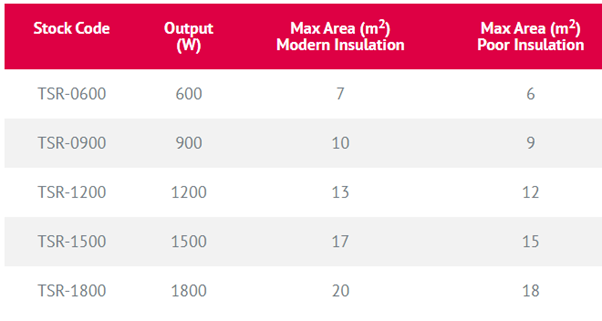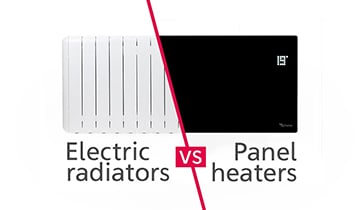5 min read
What’s the difference between electric radiators and panel heaters?
In this blog we run through the difference between electric radiators and panel heaters. If you are thinking about giving your home heating a bit of...

One of the most common questions we get asked in relation to electric radiators is, ‘will it heat the room to the right & required temperatures?’ The answer is pretty much always ‘yes it will’ but there are a few key points that are always worth considering to make sure you choose the right radiator for the job at hand.
In this article we’ll walk you through everything you need to know for selecting the right one and a few trouble shooting tips if you already have an electric radiator installed. However, if you are short of time and need an answer now, our Customer Experience team are on hand to help answer any questions you may have. Just head over to the contact page and start the conversation.
Just to let you know, when it comes to trouble shooting, we are going to assume that the electric radiator has power and is working correctly. If not, contact the manufacturer or the reseller where you purchased it.
Electric radiators, like all radiators, are available in different sizes and outputs. If your room is not heating to the right temperature, you need to make sure the radiator(s) is the correct output for the size of the room.
The British Thermal Unit (BTU) is a good measure of the heat a radiator with emit into the room and will help you choose the right output for the project. Basically, you need to know how much heat the room needs before selecting the radiator. Too little BTU output would mean that the space will not reach your desired temperature. There are loads of BTU calculators available for free on the web. B&Q have a good one which you can access here. To calculate the BTU you will need to measure the length, width and height of the room and account for any windows and patio doors.
But, if you know the output of the radiator in watts you can multiply that by 3.41 to get the BTU/hr and if you have the BTU, you can divide it by 3.41 to get the watts or output you need.
For example, if the output of the electric radiator is 600W then the BTU/hr would be 2,046:
600(W) x 3.41 = 2,046 (BTU/hr)
See below as an example for the ThermoSphere Oil Filled Radiator and what size rooms the radiators will heat.

We always recommend rounding up to the next nearest wattage when choosing your electric radiator to avoid purchasing a product that may not be suitable for your room size. There’s no disadvantage in purchasing a slightly higher output radiator, all this means is that the room will heat up quicker and the radiator will switch off sooner once your room is heated to the correct temperature.
Don’t forget that you can have more than 1 radiator in a room to combine the outputs to cover larger areas, or if you want to make the room heat up quicker to your desired temperature. For example, if your room was 40m2 and well insulated, then two 1800W Oil Filled Radiators would suit this perfectly.
This leads us on nicely to this next point, how well is the room insulated? Older buildings, typically tend to be less insulated. This means that however efficient your radiator is, these will waste energy and the room may never get to the desired temperature if the property loses its heat too quickly by having a higher heat loss. Small changes and home improvements can be made to help improve thermal retention, such as fitting window blinds/curtains, additional loft insulation, or draft excluders etc. It’s also worth investing in a heat loss calculation to help identify the required heat output needed for the room.
There are a couple of different types of electric radiator available – the main types being convectors, or radiant (typically oil or gel filled). A convector radiator has dry elements which heat up and transfer warmth to the surrounding air which rises, and moves through the room. If your room has high ceilings, then convected heat will be lost up into the higher spaces, and your room may not feel warm.
Radiant heaters however, heat up a thermal fluid inside the radiator, typically either oil or gel filled. This then transfers warmth to the surrounding air. As this is not convecting (moving) the air, it will heat objects in its path – walls, surfaces, people etc. This can mean that it will be more effective in a room with higher ceilings.
Whilst convectors are quick to heat they are also quick to cool, whereas oil-filled electric radiators are able to retain heat for longer but are slower to respond to changes in room temperature.
If the room in question is being used often, with doors leading to other areas/externally, then every time the door is opened then there will be heat lost. This can mean that the room may not be able to heat up to the desired temperature.
Ensure the radiators are set up to a heating schedule which suits with the times the room is in the highest demand.
Ensure that the thermostat on your radiator is set up correctly – heating to the right temperature. A comfortable room temperature is usually between 200C-220C, so this is all the radiator will need to be set at.
Being able to accurately control and programme your electric radiator key to ensuring energy efficiency is maintained and heating bills don’t go through the roof. Each of our electric radiators are programmable, include a digital thermostat and are able to monitor the room temperature precisely. This means that the electric radiator turns on less often, and doesn’t unnecessarily use more power than needed which reduces energy consumption.
So, that’s it for now. Why not check out our range of electric radiators here or talk to one of the team if you have any further questions.

5 min read
In this blog we run through the difference between electric radiators and panel heaters. If you are thinking about giving your home heating a bit of...

6 min read
When looking at different heating systems for your home, running costs play a big factor as to which system you decide upon. Even though it is worse...

6 min read
With a big shake-up well underway for how we heat homes, more homeowners are exploring different ways to heat their homes in a more cost-effective...